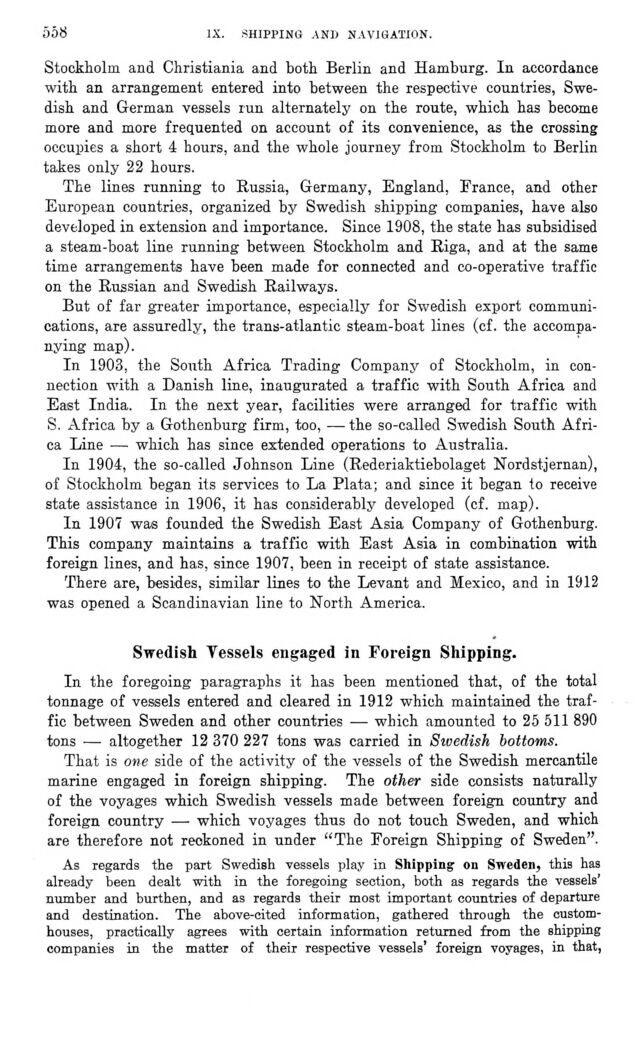
Full resolution (JPEG) - On this page / på denna sida - IX. Shipping and Navigation. By H. Rosman

<< prev. page << föreg. sida << >> nästa sida >> next page >>
Below is the raw OCR text
from the above scanned image.
Do you see an error? Proofread the page now!
Här nedan syns maskintolkade texten från faksimilbilden ovan.
Ser du något fel? Korrekturläs sidan nu!
This page has never been proofread. / Denna sida har aldrig korrekturlästs.
■558
ix. shipping and navigation.
Stockholm and Christiania and both Berlin and Hamburg. In accordance
with an arrangement entered into between the respective countries,
Swedish and German vessels run alternately on the route, which has become
more and more frequented on account of its convenience, as the crossing
occupies a short 4 hours, and the whole journey from Stockholm to Berlin
takes only 22 hours.
The lines running to Russia, Germany, England, France, and other
European countries, organized by Swedish shipping companies, have also
developed in extension and importance. Since 1908, the state has subsidised
a steam-boat line running between Stockholm and Riga, and at the same
time arrangements have been made for connected and co-operative traffic
on the Russian and Swedish Railways.
But of far greater importance, especially for Swedish export
communications, are assuredly, the trans-atlantic steam-boat lines (cf. the
accompanying map).
In 1903, the South Africa Trading Company of Stockholm, in
connection with a Danish line, inaugurated a traffic with South Africa and
East India. In the next year, facilities were arranged for traffic with
S. Africa by a Gothenburg firm, too, —the so-called Swedish South
Africa Line — which has since extended operations to Australia.
In 1904, the so-called Johnson Line (Rederiaktiebolaget Nordstjernan),
of Stockholm began its services to La Plata; and since it began to receive
state assistance in 1906, it has considerably developed (cf. map).
In 1907 was founded the Swedish East Asia Company of Gothenburg.
This company maintains a traffic with East Asia in combination with
foreign lines, and has, since 1907, been in receipt of state assistance.
There are, besides, similar lines to the Levant and Mexico, and in 1912
was opened a Scandinavian line to North America.
Swedish Vessels engaged in Foreign Shipping.
In the foregoing paragraphs it has been mentioned that, of the total
tonnage of vessels entered and cleared in 1912 which maintained the
traffic between Sweden and other countries — which amounted to 25 511 890
tons — altogether 12 370 227 tons was carried in Sivedish bottoms.
That is one side of the activity of the vessels of the Swedish mercantile
marine engaged in foreign shipping. The other side consists naturally
of the voyages which Swedish vessels made between foreign country and
foreign country — which voyages thus do not touch Sweden, and which
are therefore not reckoned in under "The Foreign Shipping of Sweden".
As regards the part Swedish vessels play in Shipping- on Sweden, this has
already been dealt with in the foregoing section, both as regards the vessels’
number and burthen, and as regards their most important countries of departure
and destination. The above-cited information, gathered through the
customhouses, practically agrees with certain information returned from the shipping
companies in the matter of their respective vessels’ foreign voyages, in that,
<< prev. page << föreg. sida << >> nästa sida >> next page >>